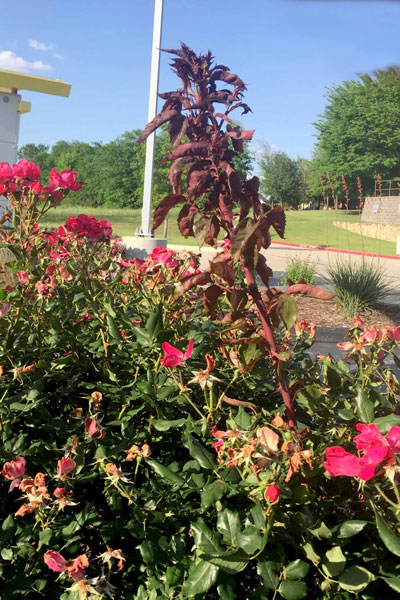Question of the Week: April 20, 2017
“Neil, is this rose rosette virus? How can I tell for sure?”
I’m not sure why rose rosette virus (RRV) has decided to camp out in the Dallas/Fort Worth Metroplex and ruin all of the roses, but that’s exactly what it’s done in the past five years.
After many notes, calls, posts and pleas everywhere I went last weekend, I put a Garden Tip regarding RRV up on my Facebook page. At this point, it and a follow-up post with two additional photos have been read by right at 100,000 people. Obviously, it’s a point of very great concern to gardeners.
I’ve reworked the text, but the content is the same in case you didn’t see it last weekend.

Photo: Bull cane, deep red coloration and deformed buds and flowers are all visible on this Knockout red rose.
Garden Tip: Those of you in the DFW area know this sight all too well. This is the fatal rose rosette virus on Knockout red roses in a photo from last weekend in McKinney – but RRV is all across the Metroplex. No neighborhood has been spared. Curiously, it isn’t nearly as common elsewhere in Texas, but that could change very quickly, so here are my tips and tidbits.
Telltale symptoms and responsibilities…
• Extremely strong new shoots, often referred to as “bull canes.” They almost look like they have herbicide damage.
• Will initially affect isolated branches, but you need to know that the entire plant is infected at this point and must be removed.
• Note the deep red coloration in the new shoot in this photo.
• Often crazily thorny stems on those bull canes. This particular plant, however, was not especially thorny.
• Flower buds and flowers look normal at first, but then you realize that they are not opening properly. You can see that in this photo.
• This virus is spread by a microscopic, wind-borne mite for which we have no control.
• People who insist that their roses are not infested (when they really are), as well as commercial landscape companies, park departments and highway maintenance people who merely prune to remove the obviously infested stems are all doing all other rose growers a great disservice.
• This virus seems to impact almost all types of roses. Texas A&M is conducting a major research program in conjunction with many other states and trade organizations. Hopefully they will find us a work-around before too much more time passes.
• In the meantime, I am very reluctant to recommend replanting more roses in DFW. You’re better off planting shrubs and supplementing them with color from annuals and perennials.
• TAMU plant pathologists and rose societies tell us to dig the affected plants out, roots and all, put them in black plastic trash bags and send them to the landfill. Do not believe that crazy home remedies will work. They do not!

Photos: These closer photos show you the extreme size of the infected bull cane as well as the mass of new growth on another infected stem. This plant should be removed immediately. There is no cure for this virus, nor is there a way to stop the spread of the microscopic, wind-borne mite.
Favor to ask: Please do not post photos of your roses to my Facebook page to ask if they have rose rosette virus. I just can’t keep up with all of them, and so often folks post photos that don’t show the plant well enough for anyone to be able to tell. With these points above, you should be able to tell very quickly on your own, just from your own visual observations. (You get to see the plants life-size!)
